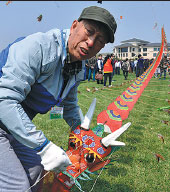Culture, history come alive on city's streets
Since I arrived in the country, one of my favorite things about China is the ever-present feeling of history.
Coming from the United States, I find that my nation's visible history only dates back a few centuries, and it is hard to feel truly immersed in the past.
History is, however, a deep-seated part of Weifang's identity, and I was constantly impressed with how it continues to surface in contemporary culture.
Weifang is famous for its kites, and rightly so. Kite flying is said to have been invented here 2,400 years ago, and Weifang remains an important center for kite production. This ancient tradition is especially prominent in the village of Wangjiazhuangzi, where 87 kite workshops together produce nearly 200 million yuan worth of consumer-level kites.
But Weifang's history is not tied solely to kite making. For instance, Qingzhou, a county-level city in eastern Weifang, served as a regional hub city during the Eastern Han dynasty (AD25-220) to Three Kingdoms (AD220-280) and remains a captivating city today.
Qingzhou boasts China's first national museum based in a county-level city. I loved the museum, which houses more than 40,000 ancient Chinese relics, ranging from pottery to dagger-axes.
We also visited the Qingzhou Songcheng project, a tourist street designed to display intangible cultural heritage. The renovated street is built to appear ancient with its cobbled streets and stone archways, but it is different from many other renovated old streets in China because it is home to many longtime residents.
I had a lot of fun walking up and down this street and seeing so many traditional Weifang arts being performed. The expressive and shockingly spry Li Guangwu demonstrated a folk dance called butterfly catching. With its headstands and leaps, the dance would have been impressive even if Li wasn't 71 years old.
I tried playing a violin, which despite being similar to the erhu, is a distinct part of Weifang's intangible cultural heritage. After only managing to produce a horrible, screeching wail from the two-stringed instrument, I discovered a newfound appreciation for Chinese folk musicians.
Of the places I've been in China, I can't think of anywhere with a more immediately immersive cultural history than Weifang. Sure, the Great Wall and the Forbidden City are just as old, but at the end of the day, they're simply structures. In Weifang, the ancient past manifests itself in the arts and practices of its people, from kite making to folk dancing.
Contact the writer at iancallison@chinadaily.com.cn
|
Weifang is renowned for its kite art and production dating back 2,400 years. |
(China Daily 07/14/2016 page6)















